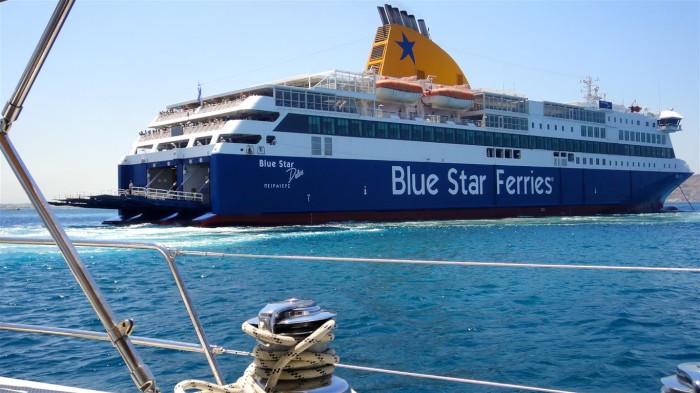Life After Cruising
Ecuador and Panama It’s been a year since we sold Berkeley East and ended 15 years of cruising in the US,...

We’ve anchored close to ferry docks before, but never as close as in Naxos Town. And the ferries have never been as big, or as frequent, with two or three arriving and departing at one time. Some were high-speed catamarans, others, traditional car ferries ranging in size from 300 to 500 feet, with room for 2400 people and 430 vehicles. Several times each day, the long concrete dock in Naxos would bustle with activity. Cars and trucks lined up causing backups all the way through town. Buses unloaded scores of people who hurried along with their children and rolling bags in tow. And the port police efficiently directed the chaos, with waves and whistles, in an effort to keep these massive island hoppers on schedule. We felt the rumble in the sea as they came near, heard the blast of their horns as they entered the harbor, and saw the roll of their wakes move toward us as they dropped anchor and spun to back into the dock just 100 feet behind Berkeley East.


At first it was exciting, though sometimes a bit scary as we wondered if the high-speed catamaran would be able to stop before swallowing Berkeley East, and us, whole. After a few days, we found amusement watching the reactions of people on other boats who anchored behind us, totally oblivious that they were in the ferry path until it was too late.

The island of Naxos, in the central Cyclade island chain of Greece, has a lot to offer the average cruiser.



In addition to the ferry entertainment, the anchorage is well protected, and has a view of the elegant Venetian style town and the Portara, a massive doorway that leads to nowhere. The Portara is the entrance to an unfinished Temple of Apollo that was begun about 530 BC. While the temple was slowly dismantled, the door, with four blocks of marble, each 16 feet long and weighing 20 tons, was so large it couldn’t be moved.


Every evening, without fail, there was a parade of people up the hill to the Portara for sunset.

And when the fiery ball disappeared behind the sea wall, Naxos Town glowed, looking more like a painting, with perfect light and just the right splash of color.


The old town was lovely, with one of the best Greek restaurants we have found to date. Meatballs drenched in Roquefort, veal with feta and capers, lamb baked in Greek red saffron and spearmint, all won rave reviews from those of us who had all but given up on Greek food.
Having gained some experience in Greek island driving, we have learned that bigger is definitely not better, and good condition is very bad. So for a spin around the Naxos, we passed on the cute, new fun cars in favor of a dirty beat up wreck that would not suffer from a few new scratches or dents. As we sweated with no AC and leaned forward to help the sad little automobile inch uphill, we decided we needed to adjust our criteria up just a little. Luckily, “the little engine that could” took us safely through the island’s interior, which is breathtaking, not only because of the dramatic mountains and green valleys, but also due to the roads that literally took your breath away with steep climbs, sheer cliffs and endless switchbacks.


Just outside of Appollon there is partially complete kouros that lies in an ancient marble quarry It is believed that the 35 foot marble statue represents Dionysos (the god of the grape harvest, winemaking and wine), and was abandoned in the 6th century BC, unfinished, because it cracked.
Previous Comments
Awesome photos, Mary!